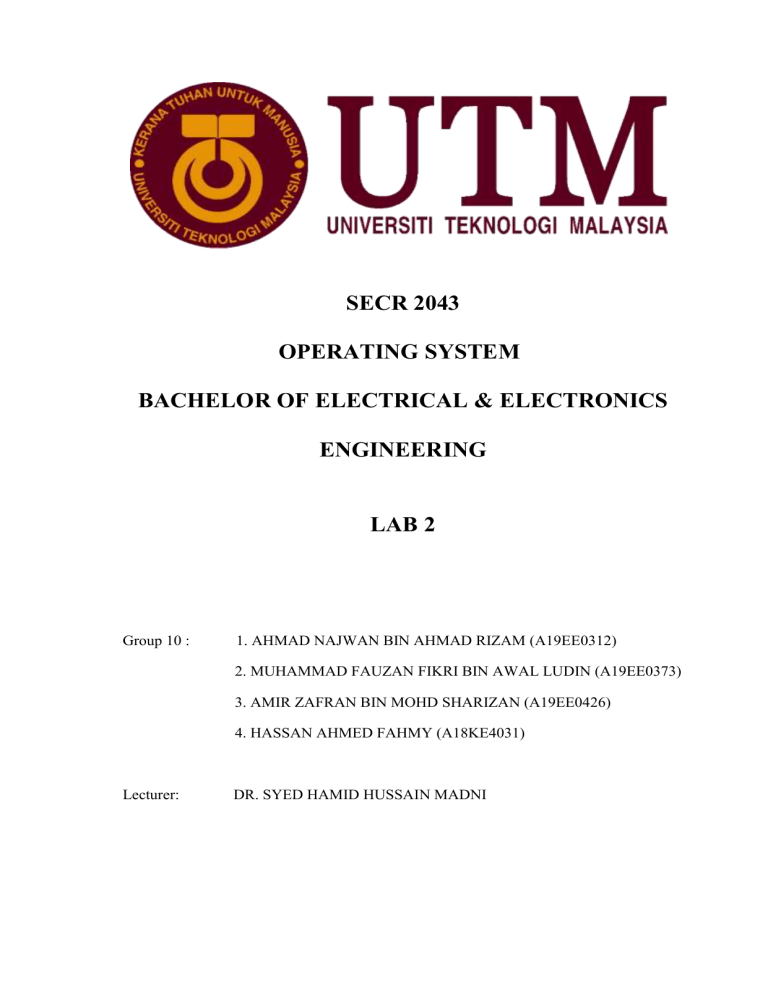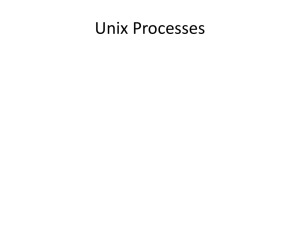
SECR 2043
OPERATING SYSTEM
BACHELOR OF ELECTRICAL & ELECTRONICS
ENGINEERING
LAB 2
Group 10 :
1. AHMAD NAJWAN BIN AHMAD RIZAM (A19EE0312)
2. MUHAMMAD FAUZAN FIKRI BIN AWAL LUDIN (A19EE0373)
3. AMIR ZAFRAN BIN MOHD SHARIZAN (A19EE0426)
4. HASSAN AHMED FAHMY (A18KE4031)
Lecturer:
DR. SYED HAMID HUSSAIN MADNI
Lab 2
REFER CHAPTER 3 PROCESS ANIMATION
Example: An execution of program 1 produces a process tree, an output, and process identifier assignment as
shown in Figure 1. The parent process identifier is assumed to have been assigned with an integer 21, while the
child is assigned with the next available identifier i.e 22.
# include <stdio.h>
# include <unistd.h>
main() {
int pid1;
printf(“ \n Hello World\n”);
pid1=fork();
if (pid1 < 0 )
printf(“\n Error in forking \n”)
else if (pid1 == 0)
printf(“\n Knock! Knock! Knock!\n”);
else (pid1 > 0)printf(“\n Please come in \n”);
}
Program 1
Q1 :
id = 21
pid1 = 22
Hello World
Please Come in
id = 22
pid1 = 0
Knock! Knock! Knock!
Figure 1: Process tree of program 1
Firstly, understand the coding and rewrite back using UNIX program.
Then, draw a process tree (as in Figure 1) to illustrate the parent-child relationship for the C code given
in program 2.
For each node on the tree, write the following information:
i.
The process identifier (assumed that the parent process identifier is assigned, id=21).
ii.
The return value of the fork() statement
iii.
Generated output
# include <stdio.h>
# include <unistd.h>
main()
{
int pid1, pid2, pid3;
pid1=fork();
if (pid1 == 0)
printf(“\n I love \n”);
else
{
printf(“\n Operating system\n”);
pid2=fork();
if (pid2 == 0)
printf(“\n class, \n”);
else
{
printf(“\n difficult \n”);
pid3=fork();
printf(“\n but interesting!!\n”);
}
}
}
Program 2: Generation of child process
Solution:
Id = 21
PID1 = 22
PID2 = 23
Operating system
Class,
Id = 22
Id = 23
PID1 = 0
PID1 = 22
PID2 = 0
PID3 = 24
I love
difficult,
but interesting!!
Id = 24
PID1= 22
PID2 = 0
PID3 = 0
but interesting!!
Q2: Referring to Figure 2, write a full program that will create five processes called original, clone1, clone2,
clone3, and clone4.
Each process displays a message that illustrates the parent-child/children relationship between the two
processes.
i. Process original will print output as follows:
“I am the PARENT, my process identifier is id_parent, my clones are: “
process clone1: id_child1
process clone3: id_child3”
ii.
Process clone1 will print output as follow:
“I am the obsolete VERSION; the recent version is id_child2”
iii.
Process clone4 will print the following message:
“I am the most SOPHISTICATED CLONE, process identifier of my parent is id_child3 ”
original
clone1
clone3
clone4
clone2
Figure 2: Tree of five processes
Solution:
#include <stdio.h>
#include <unistd.h>
int main()
{
int pid_clone1, pid_clone2, pid_clone3, pid_clone4;
pid_clone1 = fork();
pid_clone3 = fork();
if (pid_clone1 = = 0 && pid_clone3 !=0)
{
pid_clone2 = fork ();
if (pid_clone2 = = 0)
{
Print ( “ I an obsolete version, recent version is %d\n”,getpid() );
}
else ()
}
else if (pid_clone3 = = 0 && pid_clone1 !=0)
{
pid_clone4 = fork ();
if (pid_clone4 = = 0)
{
printf (“I am the most sophisticated clone, process identifier of my parent
is %d\n”, getpid() );
}
else
{
printf (“I am clone3: &d\n “, getpid ());
}
else if (pid_clone3 !=0)
{
printf(“ I am the original process, my process identifier is %d, my clones
are : \n”, getpid () );
printf (“process clone1: %d\n”, pid_clone1);
printf (“process clone3: %d\n”, pid_clone3);
}
}


